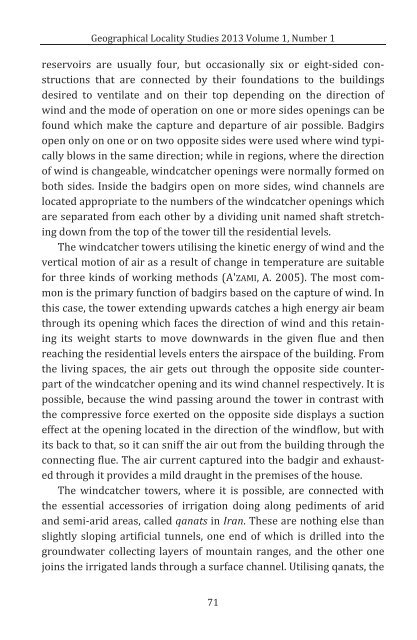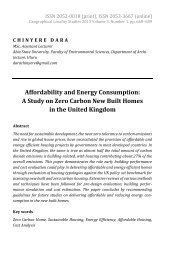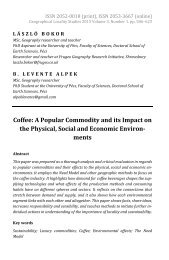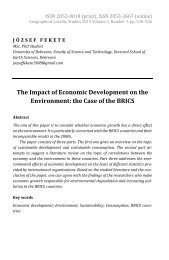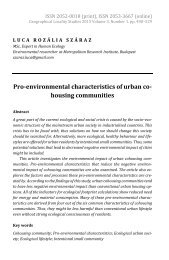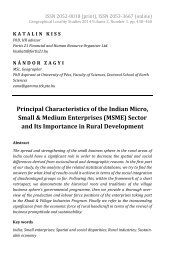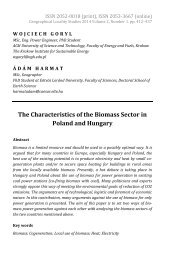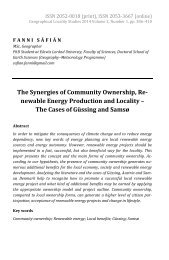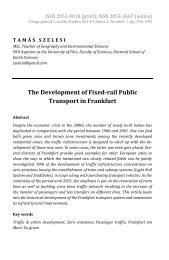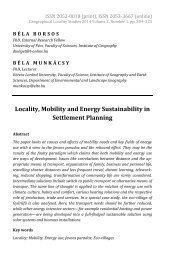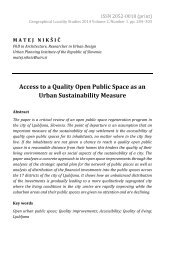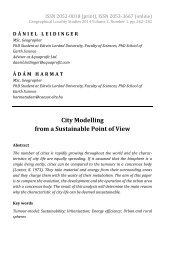Nándor Zagyi: Traditional Energy – Free Solutions for Ventilation and Air-Cooling in Arid Tropical Areas of Asia
Nowadays, more and more air-conditioning devices are installed to cool the inner spaces of dwelling and public buildings in the populous developing countries. Therefore, it is worth drawing attention to those traditional methods and architectural forms by which comfortable air conditions could be generated in the hot arid and semi-arid areas of the Planet.
Nowadays, more and more air-conditioning devices are installed to cool the inner spaces of dwelling and public buildings in the populous developing countries. Therefore, it is worth drawing attention to those traditional methods and architectural forms by which comfortable air conditions could be generated in the hot arid and semi-arid areas of the Planet.
You also want an ePaper? Increase the reach of your titles
YUMPU automatically turns print PDFs into web optimized ePapers that Google loves.
Geographical Locality Studies 2013 Volume 1, Number 1<br />
reservoirs are usually four, but occasionally six or eight-sided constructions<br />
that are connected by their foundations to the build<strong>in</strong>gs<br />
desired to ventilate <strong>and</strong> on their top depend<strong>in</strong>g on the direction <strong>of</strong><br />
w<strong>in</strong>d <strong>and</strong> the mode <strong>of</strong> operation on one or more sides open<strong>in</strong>gs can be<br />
found which make the capture <strong>and</strong> departure <strong>of</strong> air possible. Badgirs<br />
open only on one or on two opposite sides were used where w<strong>in</strong>d typically<br />
blows <strong>in</strong> the same direction; while <strong>in</strong> regions, where the direction<br />
<strong>of</strong> w<strong>in</strong>d is changeable, w<strong>in</strong>dcatcher open<strong>in</strong>gs were normally <strong>for</strong>med on<br />
both sides. Inside the badgirs open on more sides, w<strong>in</strong>d channels are<br />
located appropriate to the numbers <strong>of</strong> the w<strong>in</strong>dcatcher open<strong>in</strong>gs which<br />
are separated from each other by a divid<strong>in</strong>g unit named shaft stretch<strong>in</strong>g<br />
down from the top <strong>of</strong> the tower till the residential levels.<br />
The w<strong>in</strong>dcatcher towers utilis<strong>in</strong>g the k<strong>in</strong>etic energy <strong>of</strong> w<strong>in</strong>d <strong>and</strong> the<br />
vertical motion <strong>of</strong> air as a result <strong>of</strong> change <strong>in</strong> temperature are suitable<br />
<strong>for</strong> three k<strong>in</strong>ds <strong>of</strong> work<strong>in</strong>g methods (A'ZAMI, A. 2005). The most common<br />
is the primary function <strong>of</strong> badgirs based on the capture <strong>of</strong> w<strong>in</strong>d. In<br />
this case, the tower extend<strong>in</strong>g upwards catches a high energy air beam<br />
through its open<strong>in</strong>g which faces the direction <strong>of</strong> w<strong>in</strong>d <strong>and</strong> this reta<strong>in</strong><strong>in</strong>g<br />
its weight starts to move downwards <strong>in</strong> the given flue <strong>and</strong> then<br />
reach<strong>in</strong>g the residential levels enters the airspace <strong>of</strong> the build<strong>in</strong>g. From<br />
the liv<strong>in</strong>g spaces, the air gets out through the opposite side counterpart<br />
<strong>of</strong> the w<strong>in</strong>dcatcher open<strong>in</strong>g <strong>and</strong> its w<strong>in</strong>d channel respectively. It is<br />
possible, because the w<strong>in</strong>d pass<strong>in</strong>g around the tower <strong>in</strong> contrast with<br />
the compressive <strong>for</strong>ce exerted on the opposite side displays a suction<br />
effect at the open<strong>in</strong>g located <strong>in</strong> the direction <strong>of</strong> the w<strong>in</strong>dflow, but with<br />
its back to that, so it can sniff the air out from the build<strong>in</strong>g through the<br />
connect<strong>in</strong>g flue. The air current captured <strong>in</strong>to the badgir <strong>and</strong> exhausted<br />
through it provides a mild draught <strong>in</strong> the premises <strong>of</strong> the house.<br />
The w<strong>in</strong>dcatcher towers, where it is possible, are connected with<br />
the essential accessories <strong>of</strong> irrigation do<strong>in</strong>g along pediments <strong>of</strong> arid<br />
<strong>and</strong> semi-arid areas, called qanats <strong>in</strong> Iran. These are noth<strong>in</strong>g else than<br />
slightly slop<strong>in</strong>g artificial tunnels, one end <strong>of</strong> which is drilled <strong>in</strong>to the<br />
groundwater collect<strong>in</strong>g layers <strong>of</strong> mounta<strong>in</strong> ranges, <strong>and</strong> the other one<br />
jo<strong>in</strong>s the irrigated l<strong>and</strong>s through a surface channel. Utilis<strong>in</strong>g qanats, the<br />
71


